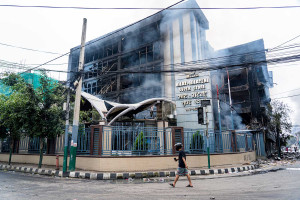Money
Remittances to Nepal top Rs200 billion a month for first time
Strong dollar, tighter checks on illegal transfers, and festive spending push remittances to record highs.
Sangam Prasain
Nepal’s monthly remittance inflows have crossed the Rs200 billion mark for the first time, driven mainly by a stronger US dollar and stricter Anti-Money Laundering (AML) measures that have improved transparency and security in money transfers.
A report released by Nepal’s central bank on Sunday shows remittances reached Rs201.22 billion from mid-September to mid-October, up from Rs144.17 billion during the same period last year.
The record inflow reflects the seasonal surge during the major festivals—Dashain, Tihar and Chhath—when Nepalis abroad typically send more money home. Economists say nearly 40 percent of annual GDP-related economic activity occurs during this festive period.
Remittance inflows rose 35.4 percent to Rs553.31 billion in the first quarter of the fiscal year 2025–26, compared to an 11.9 percent rise in the same period a year ago.
A combination of factors has underpinned the surge: rising outmigration amid scarce domestic job opportunities, a sluggish economy, political uncertainty and the stronger US dollar.
In the first quarter alone, 200,716 Nepalis left the country with work permits—an 18 percent year-on-year rise—equivalent to nearly 2,230 departures daily. This figure does not include students and visitors.
Economists warn that with a stagnant manufacturing base, weak economic growth and persistent political instability, unemployment could rise further, accelerating the outflow of young workers in the coming years.
The central bank report shows that 123,459 individuals received first-time approval for foreign employment and 77,257 renewed their permits, totalling 200,716 departures in the first quarter. By comparison, the same period last year saw 170,593 departures—110,654 first-timers and 59,939 renewals.
In the last fiscal year, 839,266 Nepalis left for foreign employment, comprising 505,957 first-time migrants and 333,309 renewals. The year before, the total stood at 741,297. These figures do not include the 119,409 Nepali students who left the country in 2024.
Despite soaring remittances and a swelling foreign exchange reserve, the inflows have not translated into job creation at home. Gross foreign exchange reserves have reached Rs2.97 trillion, or $21.21 billion—enough to sustain 16.4 months of imports of goods and services.
Business leaders say that although remittance inflows and investable capital in financial institutions have grown, low development spending and weak market demand have kept the economy sluggish. “Due to low development spending and weak demand, the economy remains slow,” wrote Prabal Jung Pandey, executive director of Lomus Group, on Facebook.
Incentives for using formal channels have also shifted a large share of remittances away from informal networks towards regulated systems, ensuring better documentation and a clearer picture of the country’s actual financial inflows.
Labour experts say the global market for Nepali workers is expanding, with a noticeable shift towards Western destinations rather than traditional Gulf countries. Stronger currencies—especially the dollar, euro and pound—have further boosted remittance earnings.
Digitisation has also played a crucial role. “One major change in remittance outflow is digitisation,” said Jeevan Baniya, labour researcher and deputy director at Social Science Baha.
Until a few years ago, South Korea was considered a major source of remittances sent through hundi, an informal and illegal channel. In 2017, the International Organisation for Migration in Seoul told The Korea Times that more than 80 percent of Nepali workers in Korea used hundi to send money home, largely due to limited formal service options.
“Now, in South Korea, all kinds of banking services and peer-to-peer transactions have gone digital in a big way,” Baniya said. “So money is coming through legal channels.”
Baniya added that the rising number of Nepali students in Japan, Australia and Canada, along with higher basic wages in many labour destinations, has also contributed to increased remittance inflows.
Experts say strengthened AML compliance in recent years has improved trust in formal channels and will likely continue pushing more remittances into the official system.
According to Guru Prasad Paudel, spokesperson for Nepal Rastra Bank, three factors are driving the growth in remittances: rising outmigration, the appreciation of the US dollar against the Nepali rupee and the shift of Nepalis towards higher-wage destinations.
He said the Nepali currency depreciated 2.3 percent against the US dollar between mid-July and mid-October 2025. The buying exchange rate stood at Rs140.22 per dollar in mid-October, compared to Rs137 in mid-July.
“Yes, the rise in remittance has increased the country’s foreign currency reserve, and the lack of spending capacity has also become a challenge. But this shows that opportunities are waiting for us,” Paudel said.
“Our statistics show that the import of intermediate goods is rising, and this is a good sign,” he added. Intermediate goods are producer or semi-finished goods used as inputs in the production of other goods, including final products. “The rise in these goods means we are adding value and exporting it.”
The surge in remittances also coincides with heightened youth unrest at home. In early September, youth-led nationwide protests—spanning issues ranging from corruption and governance failures to unemployment and police accountability—disrupted businesses, caused huge losses to public and private property, and dented investor confidence.
Economists say the protests reflect deep frustration among young people with shrinking job opportunities in the domestic market. Political instability, repeated changes of government, stalled development projects and weak private-sector hiring have combined to limit employment growth.
For many young Nepalis, migration has become the only viable option for escaping instability and economic stagnation.
The continued failure of agriculture, manufacturing and services to generate meaningful employment reinforces the cycle: as instability fuels unemployment, more young people leave, and remittances rise—but at the cost of a depleted workforce, weakened productivity and long-term economic vulnerability.
Nepal’s dependence on remittances has deepened to the point that it has effectively become a labour-exporting economy, with rural households in particular relying on at least one family member’s income from abroad, according to the central bank study.
Political uncertainty, rampant corruption and poor accountability remain core obstacles to economic transformation, pushing both skilled and unskilled youth to leave in search of stability and opportunity elsewhere.




 8.12°C Kathmandu
8.12°C Kathmandu













%20(1).jpg&w=300&height=200)
